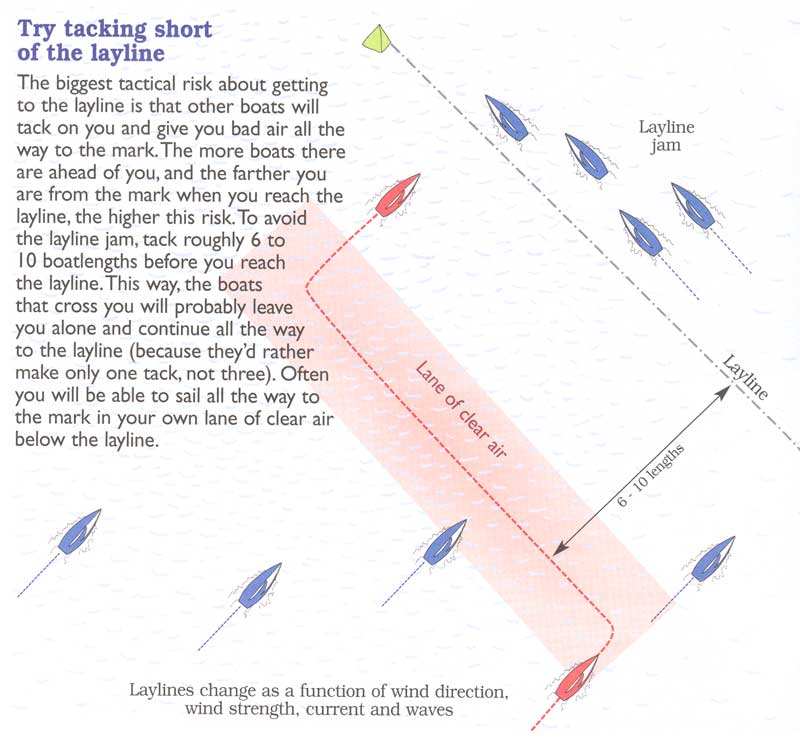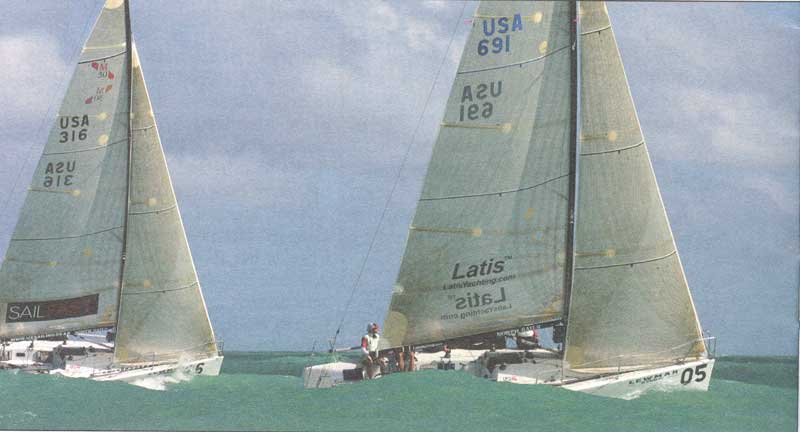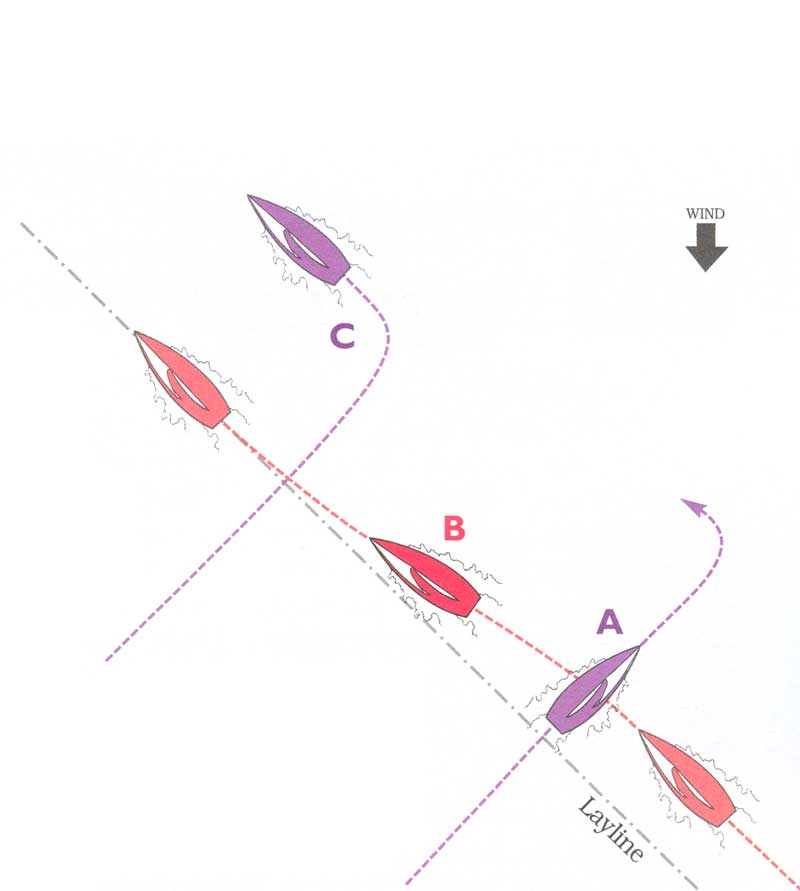Smart Moves Near the Laylines
by David Dellenbaugh
The layline is a critical part of any
windward leg because every boat has to get there eventually and, once they
do, itís a tactical dead-end. The closer you come to a layline, the fewer
options you have, so you need smart tactics whenever you are approaching (or
avoiding) it.
When youíre behind
Going to the layline when there are boats ahead of you is like running into
a dead-end alley while you are being chased: there is no escape. So when
youíre behind, a basic tactical rule of thumb is to stay away from the
laylines.
Of course, you canít avoid the layline forever. But the farther you are from
the mark when you reach the layline, the more risk you take (of other boats
tacking on you). So consider tacking short of the layline (see diagram) to
keep options open.
As you get closer to the mark, itís OK to go to the layline, especially when
there arenít so many boats around you. But if you think other boats may tack
on you, go a little past the layline before tacking. This will encourage
them to tack in front of or to leeward of you (where they wonít hurt you so
much), and it will give you room to foot slightly if they do tack on your
wind.
 |
When youíre ahead
When you are concerned primarily about the boats behind you, the layline is
your friend because once you are there itís very difficult for other boats
to pass you. Therefore, another good tactical rule of thumb is to push the
boats you are beating toward a layline.
If possible, Ďherdí the boats behind you toward the layline on the unfavored
side of the course (so you will gain strategically as well as tactically)
and/or toward whichever layline is closer (so they reach the dead-end as
soon as possible). The further you are from the mark, the more effective
this tactic becomes.
 |
| Itís usually not a great idea to get to the layline first because boats that are ahead of you will then be able to tack on your wind. Therefore, before you reach the layline, take a look at the boats to windward. Are they ahead of you? If a boat on your windward hip is far enough advanced to tack in a safe leeward position, then they will give you trouble and you should consider tacking before the layline. But if they canít lee-bow you, then you can go to the layline and they wonít be a problem. Photo by J.H. Peterson. |
The port layline temptation
When you must round the windward mark to port, there is often a traffic jam
on the starboard-tack layline but hardly anyone on the port-tack layline.
Thatís because it can be difficult to tack near the mark without breaking a
rule (see rule 18.3). However, many of the boats on starboard tack have to
sail in bad air or overstand the mark. Thatís why itís often tempting to
approach on port.
When you do this, however, you must be careful tactically. If you come right
in to the mark on the port-tack layline you will be asking for trouble,
especially if youíre in the middle of a pack.
Itís almost always better to be at least several lengths to leeward of the
port-tack layline. You want to be far enough away so that, when you reach
the starboard layline and tack for the mark, you have room to complete your
tack (i.e. get to a closehauled course on starboard tack) before you enter
the two-length zone around the mark. This will make it much easier to avoid
breaking any rules (especially 18.3).
Two tacks or sail in bad air?
If youíre on the layline and a boat tacks on your wind, should you tack
twice to get clear air, or just continue sailing to the mark in bad air?
Your best tactical option depends on at least two factors:
1) How far you are from the mark. Obviously if you are only a few lengths from the mark it would be better to keep going, but if you are half a mile away itís probably better to make two tacks. The tradeoff point is some place in between where the cost of two tacks is equal to the cost of staying in bad air; and
2) How much you are being hurt by bad air. If itís windy and you can sail
almost as fast in dirty air, then you should probably keep going. But if
youíre sailing in light air (where wind shadows can really hurt), then you
should definitely consider two tacks (especially if there is any chance the
bad air means you wonít fetch the mark).
 |
| Try a ďhead-fakeĒ on the layline When youíre trying to judge the layline, it helps to look at other boats that cross ahead of you to see if they are fetching the mark. Other boats also look at your angle when they cross behind you (A). If you are fetching the mark, consider bearing off for a moment to make it look like you are below the layline (B). This way you will encourage the other boat to continue sailing past the layline, and you will round the mark farther ahead of them. This trick may also work when one of your competitors crosses ahead of you (C). If you bear off to make it look like you arenít making the mark, you may entice them to sail far enough past the layline that they will not give you bad air after they tack. |
 |
| Tack on the layline or on a boat that is overstanding? A common tactical situation near the layline happens when you converge with another boat that is overstanding the mark. If you are ahead of that boat, should you tack on the layline (A), or continue past the layline so you can tack on the other boat and give them bad air (B)! When youíre in this position on the race course, it often seems like tacking on the other boat is the better option. But more often than not, tacking on the layline is a smarter move. You decision should depend on at least three main variables; how far you are from the mark, how much the other boat has overstood, and the position of other boats. You should consider tacking on the other boat if they are far from the mark, not overstood by too much and/or other boats are not a factor. Tack on the layline when you are closer to the mark, when the other boat has overstood by a lot and/or you are worried about nearby boats. |
Dave publishes the newsletter Speed & Smarts. For a subscription call:
800-356-2200 or go to:
www.speedandsmarts.com.
All contents are copyright (c) 2007 by
Northern Breezes, Inc. All information contained within is deemed reliable
but carries no guarantees. Reproduction of any part or whole of this
publication in any form by mechanical or electronic means, including
information retrieval is prohibited except by consent of the publisher.